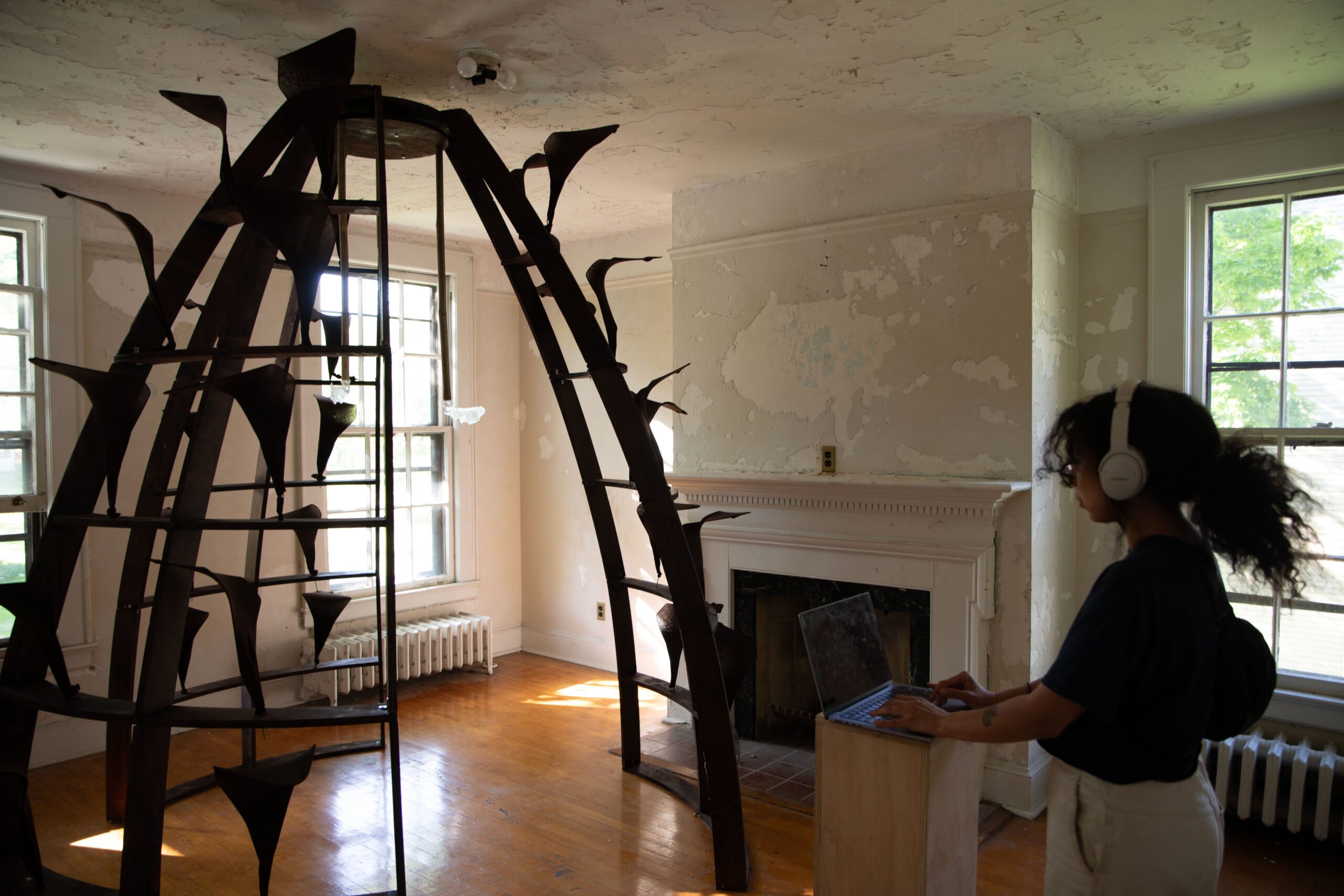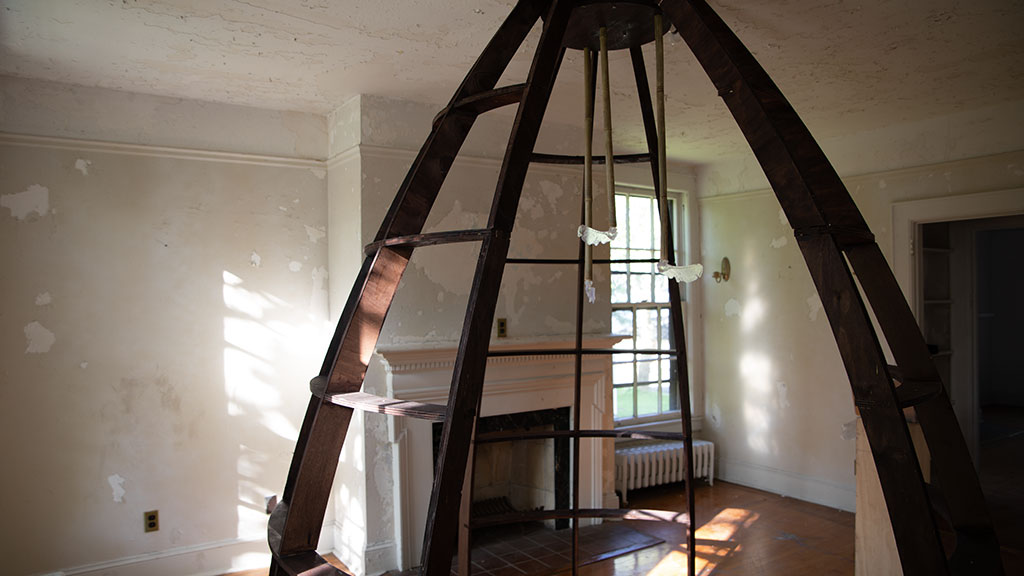earthseed
Dre Jacome
Advisor: Sarah Ibrahim
Historically, archives are sites of erasure and capture— not sovereignty. How can we reimagine archives where stories are stored as medicine with reverence and protection? Drawing on temazcal ceremony and pinecones protective form, earthseed is an experimental immersive storytelling sculpture and installation that houses intimate land/body stories with landback protocols of entry.

Abstract
Earthseed is an immersive, large-scale storytelling installation, sculpture, and archive. Inspired by temazcal ceremonies and ecological design, the sculpture takes on the architectural form of a pinecone, which houses intimate stories that are encoded onto seedpod lights. A pinecone is a opens and closes in response to the conditions of its environment; depending on its context, it decides to share its seed or to withhold. Similarly, earthseed is a living archive that withholds and discloses its seedstories according to landback protocols of entry.
Activated by a passcode and a users touch, each seedpod activates a sound collage featuring excerpts from oral history interviews conducted between me and my long time friend, Ximena Violante. These are collaged alongside political speeches from Land Day — specifically the NYC March with Palestine for Land and Liberation.
Through weaving between modern and traditional land-based technologies, the work aim to a be site of refuge and catharsis — where stories are protected, to provide medicine, to provide a compass for those who say no to settler colonialism as it shows up on the body, mind, and land.

Technical Details
- Structure Fabrication: Fusion 360, CNC Shopbot, Shaper Origin
- Seedpods + Hardware: Fusion 360, Arduino, Capacitive Sensor, LED Lights
- Entrance Gate Website: HTML, CSS, Javascript
- Audio in Seedpods: Zoom Recorder, Adobe Audition, Ableton, Field recordings, Oral History, Python,

Research/Context
My research is grounded in my relationships— to the land, to chosen family, to community ceremony, and to storytelling as a mode of cultural organizing. As a trained historian and herbalist, my work focuses on unearthing the shared personal-political stories of the land and people. And as a cultural organizer —that works closely with communications strategy for movements that advance healing justice and the solidarity economy—I believe in the need to archive our movements with protocols; otherwise, they are subject to cooptation and green colonialism under the mainstream of tech-optimism. With that in mind, my research spans three pillar areas:
**1) prototype installation** where I confirmed touch-audio-light interaction technology I needed; working with capacitive sensors, LEDs, arduino, and visual studio code which were connected through i2s communication. in this iteration, the sculpture took on the traditional temazcal form, and the stories were open-sourced audio recordings from BIPOC revolutionary elders.
**2) Methodology & protocols** around how to share story —especially with a medium such as oral history. Over the summer, I was a fellow at the Oral History Summer School where I learned more about protocols for enthusiastic consent and the diversity of considerations needed.this experience was complimented by additional readings and research.
**3) Fabrication to pinecone** where I had a deep learning curve on how to use Fusion 360 to design the seedpod molds and the pinecone architecture. designed at a scale 96 in x 96 in x 102 in — the pinecone structure designed to made to be large for physical accessibility and modular for future transport. and i had to create the
So much of my research was guided by the help of many hands, teachers, and friends. Thank you Ximena Violante, Sharon de la Cruz, David Rios, Tanika Williams, Ali Santana, Vito Ciancia, Phil Caridi, fields harrington, Quetzi, Simone Salvo, Cara Page, Erica Woodland, Oliver Yuan, An-Kai Cheng, Cindy Hu, Anna Lin, Jo Suk, Mashi Zaman, Lita Vinueza, Olive Yu, Quetzi, Amy Andrieux, Nigel, Derrick, Andrés Franco, Isaiah Bayes.

Further Reading
Parable of the Sower by Octavia Butler
https://www.akpress.org/parableofthesower.html
The Refusal Conference
https://afog.berkeley.edu/programs/the-refusal-conference
Healing Justice Lineages by Cara Page & Erica Woodland
https://www.northatlanticbooks.com/shop/healing-justice-lineages/
Dear Science & Other Stories by Katherine McKittrick
https://www.dukeupress.edu/dear-science-and-other-stories
Network Sovereignty by Marisa Elena Duarte
https://uwapress.uw.edu/book/9780295741826/network-sovereignty/
Digital Remediation by Davis McKenzie
https://scalar.usc.edu/ravenspace/as-i-remember-it/index
Healer of the Water Monster By Brian Young
https://www.barnesandnoble.com/w/healer-of-the-water-monster-brian-young/1136932314
Designs for the Pluriverse Radical Interdependence, Autonomy, and the Making of Worlds by Arturo Escobar
https://www.dukeupress.edu/designs-for-the-pluriverse/
This is For Everyone? Steps towards decolonizing the Web by Jessica Ogden, Susan Halford, Les Carr, Graeme Ear
https://eprints.soton.ac.uk/397709/1/jogden_decolonising_web.pdf
Manuel Amaru Cholango: Decolonizing Technologies and the Construction of Indigenous Futures
https://www.mdpi.com/2076-0752/8/4/163
Negotiating Online Access: Perspectives on Ethical Issues in Digital Collections by Cristela Garcia-Spitz and Noah Geraci
Archival encounters: rethinking access and care in digital
colonial archives by Daniela Agostinho
The New World Information and Communication Order: An Idea That Refuses to Die by Kaarle Nordenstreng
Toward slow archives by Kimberly Christen & Jane Anderson

